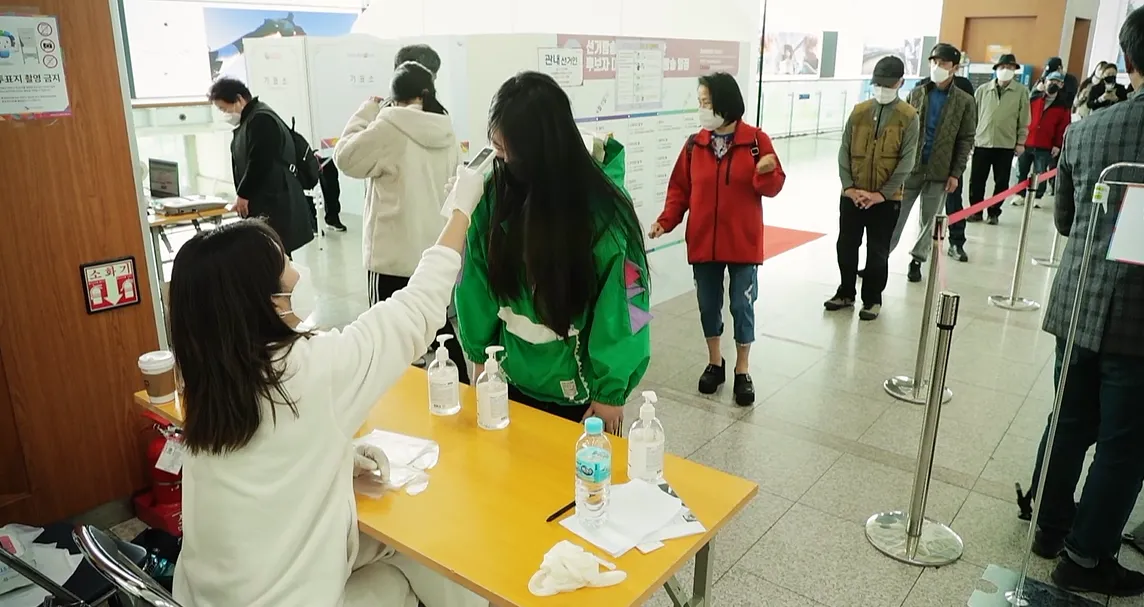Elections and Covid-19: Health and safety in polling stations

At the start of the pandemic, many countries postponed elections. From June 2020, the trend shifted to holding elections. Thanks to information sharing and peer-to-peer exchanges, election authorities gained an understanding of the risks and prevention/mitigation measures. To date, more than 100 countries and territories have held national or subnational elections that were either on schedule or initially postponed with health and safety measures. But what measures have been introduced so far? What measures have been adopted by countries that have held elections? Are the measures respected by stakeholders? Was voting safe?
Este artículo está disponible en español.
Disclaimer: Views expressed in this commentary are those of the authors. This commentary is independent of specific national or political interests. Views expressed do not necessarily represent the institutional position of International IDEA, its Board of Advisers or its Council of Member States.
This article helps to address these questions by presenting information on the health and safety measures introduced into polling stations around the world in 2020. Data was collected from electoral management bodies (EMBs), state institutions, media, and election observation reports from 52 national elections (in 51 countries) in 2020 on how in-person voting was implemented. This was the vast majority of the countries that held national elections but which also had cases of Covid-19 at the time. This analysis forms part of a series that has covered campaign limitations and will cover other parts of the electoral cycle, including special voting arrangements and international elections observation. It forms part of an ongoing study between International IDEA and the Electoral Integrity Project on Covid-19 and elections.
Health and safety guidelines
One of the first steps that EMBs or state institutions took to limit infection risk, often in collaboration with health ministries, was to introduce health and safety guidelines for the election (See Table 1). The guidelines typically focused on the voting operations or the entire electoral cycle (nomination processes, training, voter registration, campaigning, voting operations, set-up of polling stations, counting and tabulation, result announcements). Out of this sample of 20 sets of national guidelines from 19 different countries, 1 covered nomination processes, 6 training, 3 voter registration, 7 campaigning, 18 voting operations, 18 set-up of polling stations, 11 counting and tabulation, and 1 addressed result announcements.
Table 1. Covid-19 health and safety guidelines by country
Country |
Name of EMB or health authority or ministry of interior |
Guideline title |
Guideline include |
Published |
Bolivia |
Ôrgano Eletoral Plurinacional |
Protocol of Sanitary Security Measures for the 2020 General Elections |
Voting operations, set-up of polling stations, counting and tabulation |
26 August 2020 |
Brazil |
National Emergency Management Organization (NEMO) Tribunal Superior Eleitoral |
Health Security Plan for 2020 Municipal Elections |
Training, campaigning, voting operations, set-up of polling stations |
26 August 2020 |
Chile |
Servicio Electoral de Chile |
Sanitary Protocol for a Safer 2020 National Plebiscite |
Training, campaigning, set-up of polling stations, counting and tabulation, result announcements |
31 July 2020 |
Czech Republic |
Ministry of Interior |
Information for voters - hygienic-anti-epidemic measures when voting in polling stations |
Voting operations, set-up of polling stations |
10 September 2020 |
Indonesia |
General Elections Commission & Covid-19 Task Force Indonesia |
Health Protocols at Polling Stations |
Voting operations, set-up of polling stations |
27 October 2020 |
Jordan |
Independent election commission |
Instructions No. (2) of 2020 Amending Instructions to the Implementing Instructions No. (7) of 2016 on Rules of Electoral Advertising Campaigns |
Campaigning |
2020 |
Italy |
Ministry of Interior & Ministry of Health |
Health and Safety Protocols for the conduct of the 2020 Elections and Referendum |
Voting operations, set-up of polling stations |
7 August 2020 |
Liberia |
Ministry of Health |
Revised Covid-19 Declaration of National Health Emergency by the Ministry of Health |
Campaigning, voting operations |
23 July 2020 |
Lithuania |
Central Election Commission |
Decision on the Approval of the Description of the Procedures for the Organization of Elections to the Seimas of the Republic of Lithuania when Freedom of Movement of Persons is temporarily restricted in the territory or part of the Republic of Lithuania |
Voting operations, set-up of polling stations, counting and tabulation |
5 August 2020 |
Namibia |
Election Commission of Namibia |
ECN strategy to mitigate the Covid-19 impact on the 2020 regional councils and local authority elections |
Training, voter registration, campaigning, voting operations, set-up of polling stations |
2020 |
Moldova |
Central Electoral Commission |
Extraordinary National Commission on Public Health |
Voting operations, set-up of polling stations, counting and tabulation |
12 August 2020 |
Myanmar |
Union Election Commission |
Polling station officer, deputy polling station officer, and polling station members manual |
Voting operations, set-up of polling stations, counting and tabulation |
2020 |
Nigeria |
Independent National Election Commission (INEC) |
Policy on conducting elections in the context of the Covid-19 pandemic |
Nomination processes, training, voter registration, campaigning, voting operations, set-up of polling stations, counting and tabulation |
21 May 2020 |
Nigeria |
Nigeria Centre for Disease Control |
Guidelines for conducting elections during the Covid-19 outbreak in Nigeria |
Voter registration, campaigning, voting operations, set-up of polling stations, counting and tabulation |
2020 |
Singapore |
Prime Minister's Office |
The Covid-19 Special Arrangements Bill |
Voting operations, set-up of polling stations, counting and tabulation |
1 July 2020 |
South Korea |
National Election Commission |
Election Management in Response to Covid-19 (see appendix) |
Voting operations, set-up of polling stations, counting and tabulation |
15 April 2020 |
Sri Lanka |
Ministry of Health and Indigenous Medical Services |
Health Guidelines for Conducting the Elections amidst the Covid-19 Outbreak |
Training, voting operations, set-up of polling stations, counting and tabulation |
1 June 2020 |
St. Vincent and the Grenadines |
National Emergency Management Organization |
Advisory on the Health Protocol for the Conduct of Elections in St. Vincent and the Grenadines during the Covid-19 Pandemic |
Campaigning, voting operations, set-up of polling stations |
28 October 2020 |
Uruguay |
Corte Electoral |
Sanitary Protocol for Election Day of the Departmental and Municipal Elections |
Training, voting operations, set-up of polling stations, counting and tabulation |
3 August 2020 |
USA |
U.S. Centre for Disease Control |
Polling Locations and Voters: Interim guidance to prevent the spread of coronavirus disease 2019 (Covid-19) |
Voting operations, set-up of polling stations |
23 Nov 2020 (Updated) |
Source: Authors, constructed using EMB and country information.
Health and safety measures in polling stations
Health and safety measures for polling stations typically included rules on social distancing, the use of handwashing facilities (or hand sanitizers and disinfectants), ventilation of the polling station, the cleaning of voting materials, and personal protective equipment for polling officials. Almost all countries that have held national elections in 2020 have adopted combinations of these measures (see Table 2).
Beyond these general measures, many countries introduced innovative and extraordinary measures to decrease infection risk. These measures are country and election specific, which may have been exacerbated by spikes in coronavirus. In Sri Lanka, Myanmar, and Trinidad and Tobago, the EMBs organized mock polling stations to simulate election day and see whether the new practices would work. In Ghana and Malawi, "Covid-19 ambassadors" were tasked to manage compliance with voters' safety measures. In Jordan and Venezuela, the military took on this role. In Belize, Bolivia, Chile, Italy, Poland, and Singapore, priority queues were in place. Elderly, pregnant women and other vulnerable people could skip the lines at polling stations. For the Bolivian Presidential election, the voter rolls were divided into two-time slots for voting between 08:00-12:30 and 12:30-17:00 to prevent clustering. Commercial activities were also restricted within 100 meters of polling stations, and voting personnel were selected outside the risk groups (between the ages of 18 to 50). In Romania, upon arrival, the elector's temperature was measured at the polling station entrance, and the maximum number of persons at the same time at a polling station was set at a maximum of 15. At the entry and exit, voters had to disinfect their hands. Pens were provided at the polling stations. In Switzerland, besides adhering to the standard Covid-19 mitigating protocols, people were also encouraged to use the Swiss Covid-19 App. The App's purpose is to help stop Covid-19 from further spreading and to detect early possible second wave and tackle it effectively through contact tracing. As of 23 September, it has been downloaded over 2 million times.
Were measures respected?
Based on a review of 31 Electoral Observer Mission’s (EOMs) reports from various missions in 2020, 13 reports on Burkina Faso, Central African Republic, Croatia, Dominican Republic, Georgia, Kyrgyzstan, Moldova, Montenegro, Myanmar, Niger, Serbia, Seychelles, and Tanzania suggest that restrictions were often not consistently respected and poorly enforced. In general, EOMs stated that compliance to health and safety measured in place varied inside polling stations, and enforcing restrictions outside polling stations was difficult most of the time. The use of masks and disinfectant was followed in most cases. Adherence to social distancing rules turned out to be to most challenging in many cases due to polling stations not being spacious enough for regulations to be adhered to.
Table 2. Health and safety measures introduced during the 2020 national elections to reduce the spread of Covid-19.
Measure |
Country and election |
Social distancing |
Algeria, Belize, Bermuda, Bolivia, Burkina Faso, Chile, Croatia, Czech Republic, Dominican Republic, Egypt, Georgia, Ghana, Iceland, Iran, Jamaica, Jordan, Kyrgyzstan, Liberia, Lithuania, Malawi, Mali, Moldova, Mongolia, Montenegro, Myanmar, New Zealand, Niger, North Macedonia, Poland, Romania, Russia, Serbia, Seychelles, Singapore, South Korea, Sri Lanka, St. Vincent and the Grenadines, Suriname, Switzerland, Trinidad and Tobago, United States, Venezuela |
Personal protective equipment for polling station staff |
Algeria, Belarus, Bolivia, Burkina Faso, Burundi, Chile, Croatia, Czech Republic, Dominican Republic, Georgia, Ghana, Iran, Israel (limited measure), Jamaica, Jordan, Kuwait, Kyrgyzstan, Lithuania, Malawi, Mali, Moldova, New Zealand, Niger, North Macedonia, Russia, Serbia, Seychelles, Singapore, South Korea, Sri Lanka, St. Vincent and the Grenadines, Suriname, Trinidad and Tobago, United States, Venezuela |
Masks mandatory for voters entering polling stations |
Algeria, Belize, Bermuda, Bolivia, Burkina Faso, Chile, Czech Republic, Dominican Republic, Georgia, Ghana, Iran, Israel (limited measure), Italy, Jamaica, Jordan, Kuwait, Kyrgyzstan (annulled), Mali, Moldova, Mongolia, Montenegro, Myanmar, Namibia, Niger, North Macedonia, Poland, Romania, Russia, Serbia, Singapore, South Korea, Switzerland, United States, Venezuela |
Mandatory use of hand sanitizers |
Algeria, Belize, Bermuda, Bolivia, Burkina Faso, Burundi, Chile, Czech Republic, Dominican Republic, Georgia, Ghana, Iceland, Israel (limited measure), Italy, Kyrgyzstan (annulled), Mali, Moldova, Mongolia, Namibia, New Zealand, Niger, North Macedonia, Poland, Romania, Russia, Singapore, South Korea, Switzerland, Venezuela |
Sanitation of electoral materials / periodic cleaning of polling station / vent polling stations |
Bolivia, Croatia, Czech Republic, Dominican Republic, Egypt, Iran, Jamaica, Kyrgyzstan (annulled), Moldova, Mongolia, North Macedonia, Serbia, Singapore, United States, Venezuela |
Masks for voters provided by election commission |
Czech Republic, Dominican Republic, Egypt, Kyrgyzstan (annulled), Mali, Moldova, Mongolia Myanmar, Niger,Russia |
Temperature checks |
Bermuda, Jamaica, Kuwait, Kyrgyzstan (annulled), Moldova, Myanmar, Romania, Russia, Singapore, South Korea, Syria |
Reduced number of people allowed in polling stations |
Algeria, Burkina Faso, Chile, Dominican Republic, Ghana, Mongolia, Montenegro, North Macedonia, Romania, Russia |
The voter recommended bringing pens |
Bolivia, Chile, Iran, Lithuania, Malawi, New Zealand, Poland, Sri Lanka |
Optional use of hand sanitizers |
Croatia, Liberia, Lithuania, Malawi, Montenegro, Saint Vincent, and the Grenadines, United States, |
Disposable gloves mandatory for voters |
Iran, Israel (limited measure), Kuwait, Poland,Russia, Singapore, South Korea |
Masks recommended for voters entering polling stations |
Croatia, Liberia, Lithuania, Saint Vincent and the Grenadines, Serbia |
Extra polling station staff who will ensure compliance with health measures and social distancing |
Chile, Jamaica, Jordan (military), South Korea, Venezuela (military) |
Increased number of polling stations |
Bolivia, Myanmar, New Zealand, South Korea |
Special accommodations and priorities in queues |
Belize, Bolivia, Chile, Italy, Poland, Singapore, |
Gloves provided by EMB |
Iceland, Jordan, Kyrgyzstan (annulled), Russia |
EMB provided disposable pens |
Jamaica, Jordan, New Zealand, Romania, Russia |
Floor markings and barriers |
Bermuda, Kuwait, Myanmar, Russia |
Queue control |
Italy, New Zealand, Serbia, South Korea |
Extended working hours of polling stations |
Bolivia, Chile, Iran, Jordan, Singapore |
Mock pools |
Myanmar, Sri Lanka, Trinidad, and Tobago |
Restriction on commercial activities close to polling stations |
Belize, Bolivia |
Sanitizing of hands upon entering the polling station and before dipping into the voting ink |
Belize, Saint Vincent and the Grenadines, |
Extension of e-day from one day to several days – multi-day voting or multi-day elections |
Italy |
Recommended to use national Covid-19 tracing app |
New Zealand, Switzerland |
Limitations celebratory gatherings during result announcements |
Jordan, Trinidad, and Tobago |
Selecting voting personnel outside risk groups |
Bolivia |
Posters outside polling stations warning voter to take precautions against Covid-19 |
Tanzania |
Size of polling stations increased |
New Zealand, USA (sports stadiums) |
Delineation of voting times – for example, assigning voters specific hours or days (for instance, by last name or address) |
Singapore |
Dedicated polling booths for persons with respiratory symptoms |
South Korea |
No information on health and safety measures found |
The Central African Republic, Côte d’Ivoire, Burundi, Iran (first round of Parliamentary elections in February 2020), Guinea (Presidential elections 18 October 2020) |
Source: Authors, constructed using International IDEA, media reports, and EMB data. Note: This table is based on 51 countries that held 52 direct national elections and referendums from 21 February until 31 December 2020. All of the countries included in the table had one or more confirmed cases of Covid-19 infection. The table does not cover health and safety measures introduced during national by-elections or subnational elections.
Have all these reforms helped to protect public health? To date there have been very few reports linking voting arrangements with community transmission. However, some studies have been carried out and are at times contradictory. For example, in one study, focusing on the Wisconsin, USA, primary election showed “statistically and economically significant association between in-person voting density and the spread of Covid-19 two to three weeks after the election” whereas another study focusing on the City of Milwaukee from the Wisconsin CDC found no clear increase in cases, hospitalizations, or deaths. Beyond the US, health authorities in South Korea concluded that no local transmission occurred from the Parliamentary election held in April 2020, and a scientific article published in August substantiated this claim. In contrast, a French study on municipal elections in March 2020 suggested an increase in numbers of hospitalizations due to the polls, but mainly in areas already showing high transmission levels. However, they found that the election did not contribute to virus transmission in areas with already low levels of Covid-19.
There needs to be caution in interpreting this evidence. Without a consistent and robust estimation methodology which can link voting arrangements directly as a cause of transmission to individual voters, separate to ordinary community transmission, it is difficult to know when and where the virus was in fact caught. Variations in data availability between countries, and different methods and approaches among studies, make it very difficult to come to general conclusions. Media reports could also be less reliable in this respect; focusing on the anecdotal rather than aggregate picture-and may have the potential to spread misinformation. Nonetheless, Votebeat, a nonpartisan reporting project, provides some anecdotal evidence that many US poll workers tested positive during the November 2020 Presidential election.
Conclusion
Although risks remain, it appears that countries are more willing to hold elections because of an improved understanding of the virus. Time has also elapsed since the pandemic started, which has enabled lesson drawing from overseas, risk management plans to be adapted, and election planning to take place. Health and safety measures will clearly require further investment in elections to protect the safety of staff, campaigners, and votes. They will also be needed to assure citizens that voting is safe—so that turnout is not affected. The early publication of guidelines will help them to be implemented—and mechanisms for enforcement need to be considered by policy makers too.
|
Main findings on health and safety measures in polling stations
|





